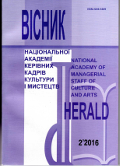LANGUAGE AND SONG AS MAJOR ASSETS OF UKRAINE
DOI:
https://doi.org/10.32461/2226-3209.2.2016.138513Keywords:
Ukrainian song, speech, Musica is therapeutic practice, psychoAbstract
The purpose of the article is to actualize Ukraine’s music and language potential in the context of modern science and music therapy practices. This potential is able to optimize the process of personality development under the difficult conditions of today’s social life. Methodology of the research embraces historical and logical, cultural and integrated techniques, as well as method of musicological analysis. These methods allow to reveal and study the ethnopsychological component of the Ukrainian song and language in order to apply its potential for the solution of the present-day individual and socio-psychological problems. Novelty of the research lies in strengthening of the idea of how a Ukrainian song and language could effectively be employed in musical therapy to protect generations of Ukrainians from destructive vibrations of the modern world and make it easier for them to resolve crises and speed up the progressive personality development. As of today, there is a worldwide developing tendency: to implement psycho-technologies which can ensure effective functioning of a man in the modern society and humanization of his development vector. It is music (an art created by the vibrations most perceptible to a living organism, i.e. the sound) that can contribute to self-realization of a person, and at the higher level – of a nation. Conclusions. Vibrational-energy characteristics of the Ukrainian language and music are a powerful potential that can help individuals and a nation to harmonize themselves and their relations with the world. Ukraine can become a center of promotion of the music-based noosphere harmonization method.
Downloads
Published
Issue
Section
License
Authors who publish with this journal agree to the following terms:
1. Authors retain copyright and grant the journal right of first publication with the work simultaneously licensed under a Creative Commons Attribution License that allows others to share the work with an acknowledgement of the work's authorship and initial publication in this journal.
2. Authors are able to enter into separate, additional contractual arrangements for the non-exclusive distribution of the journal's published version of the work (e.g., post it to an institutional repository or publish it in a book), with an acknowledgement of its initial publication in this journal.
3. Authors are permitted and encouraged to post their work online (e.g., in institutional repositories or on their website) prior to and during the submission process, as it can lead to productive exchanges, as well as earlier and greater citation of published work (See The Effect of Open Access).


